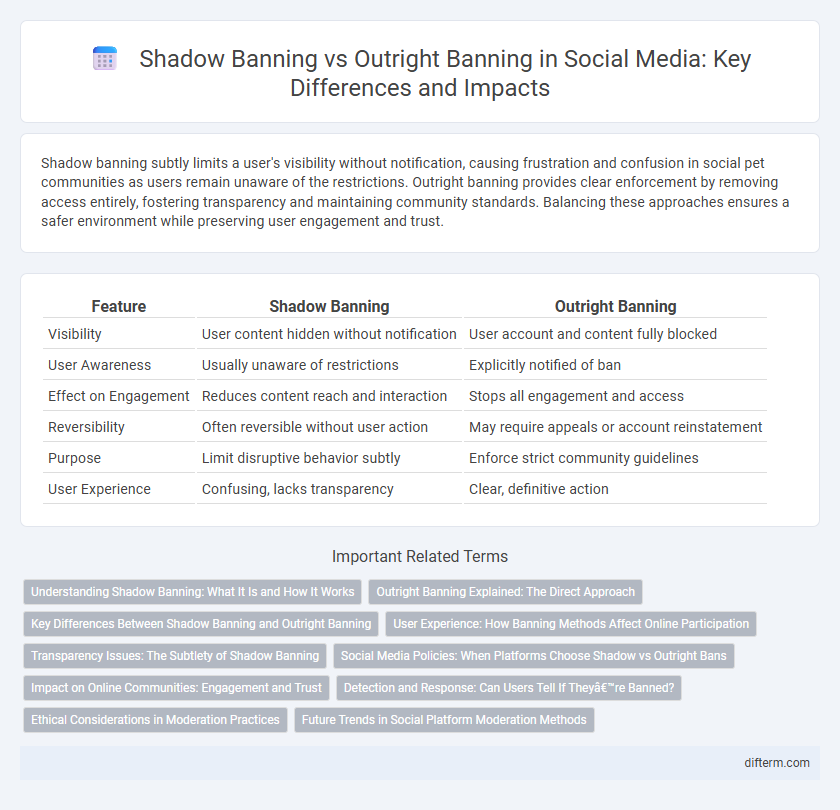Shadow banning subtly limits a user's visibility without notification, causing frustration and confusion in social pet communities as users remain unaware of the restrictions. Outright banning provides clear enforcement by removing access entirely, fostering transparency and maintaining community standards. Balancing these approaches ensures a safer environment while preserving user engagement and trust.
Table of Comparison
| Feature | Shadow Banning | Outright Banning |
|---|---|---|
| Visibility | User content hidden without notification | User account and content fully blocked |
| User Awareness | Usually unaware of restrictions | Explicitly notified of ban |
| Effect on Engagement | Reduces content reach and interaction | Stops all engagement and access |
| Reversibility | Often reversible without user action | May require appeals or account reinstatement |
| Purpose | Limit disruptive behavior subtly | Enforce strict community guidelines |
| User Experience | Confusing, lacks transparency | Clear, definitive action |
Understanding Shadow Banning: What It Is and How It Works
Shadow banning is a covert moderation technique where a user's content is hidden or less visible without their knowledge, unlike outright banning which removes access entirely. This method subtly limits engagement by restricting the reach of posts, comments, or profiles, often implemented by social media platforms to prevent disruption without confrontation. Understanding shadow banning involves recognizing its role in managing online communities while balancing user experience and content regulation.
Outright Banning Explained: The Direct Approach
Outright banning involves permanently removing a user's account or content from a platform due to violations of community guidelines, ensuring immediate cessation of their presence. This direct approach contrasts with shadow banning, where user activity becomes hidden without notification, effectively limiting reach without public acknowledgment. Outright bans provide clear enforcement, deterring harmful behavior and maintaining platform integrity through transparent consequences.
Key Differences Between Shadow Banning and Outright Banning
Shadow banning discreetly restricts a user's visibility without their knowledge, limiting their content reach while allowing account access. Outright banning permanently or temporarily disables the user's account, removing all content and interactions from the platform. Key differences lie in transparency, with shadow banning being covert and outright banning explicit, impacting user awareness and platform engagement dynamics.
User Experience: How Banning Methods Affect Online Participation
Shadow banning subtly reduces a user's visibility without direct notification, leading to confusion and frustration as users fail to understand the drop in engagement. Outright banning provides clear feedback by removing access entirely, which may prompt reflection or discourage returning participation. These contrasting methods shape online participation by either fostering silent disengagement or prompting explicit behavioral reconsideration.
Transparency Issues: The Subtlety of Shadow Banning
Shadow banning involves discreetly restricting a user's content visibility without their knowledge, complicating transparency and user trust. Unlike outright banning, which explicitly informs users of their removal, shadow banning obscures moderation actions, raising concerns over accountability on social platforms. This subtle approach can undermine user experience by creating confusion and eroding confidence in platform governance.
Social Media Policies: When Platforms Choose Shadow vs Outright Bans
Social media platforms implement shadow banning to quietly limit a user's visibility without alerting them, aiming to reduce harmful content while preserving user engagement. Outright bans remove users entirely, signaling zero tolerance for violations such as hate speech or misinformation. The choice between shadow banning and outright banning reflects a platform's strategic balance between maintaining community standards and managing public perception.
Impact on Online Communities: Engagement and Trust
Shadow banning subtly limits a user's visibility without their awareness, often preserving community engagement by avoiding immediate confrontation. Outright banning removes users entirely, which can lead to a loss of trust and open dialogue but may be necessary to maintain community standards. The choice between these moderation methods significantly shapes user interaction dynamics and influences the overall trust within online communities.
Detection and Response: Can Users Tell If They’re Banned?
Shadow banning subtly restricts user visibility, making detection difficult since posts appear normal but reach is significantly limited. Outright banning is overt, with users immediately unable to access or interact on the platform, providing clear notification of their ban status. Social platforms often lack transparent alerts for shadow bans, leading to user confusion and delayed response to restricted account activity.
Ethical Considerations in Moderation Practices
Shadow banning raises ethical concerns by obscuring content without user awareness, potentially violating transparency and trust principles in social media moderation. Outright banning enforces clear boundaries by removing harmful content but risks censorship and limiting freedom of expression. Ethical moderation balances protecting community standards while respecting user rights and promoting accountable platform governance.
Future Trends in Social Platform Moderation Methods
Future trends in social platform moderation increasingly favor sophisticated shadow banning techniques that limit visibility without user notification, aiming to reduce community disruption while curbing harmful behavior. Advanced AI algorithms analyze content context and user interactions to implement nuanced moderation, moving beyond outright banning to preserve user engagement and platform reputation. Emerging policies emphasize transparency and user appeal mechanisms, balancing automated moderation with ethical considerations in digital community management.
shadow banning vs outright banning Infographic

 difterm.com
difterm.com